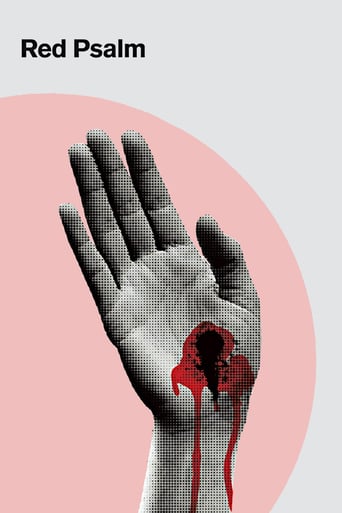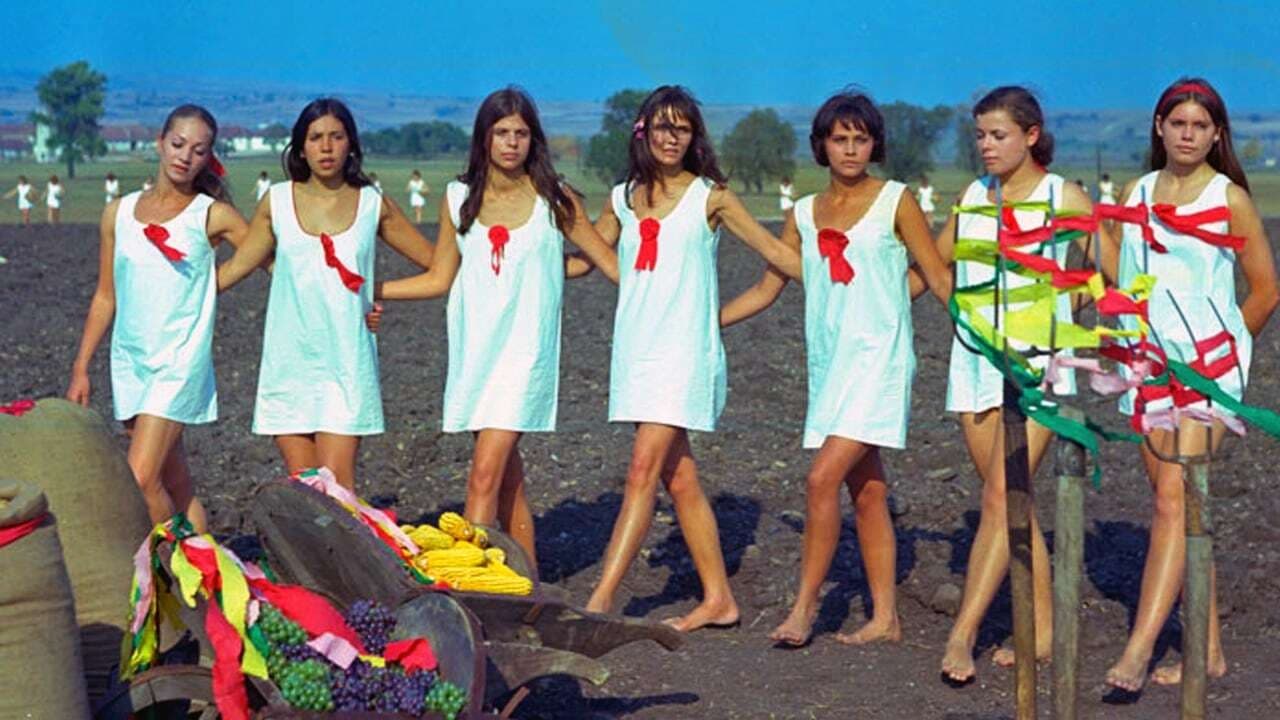Thorkell A Ottarsson
Here is something you have never seen before. A war musical with dancing naked women, armed men, choreographed walking, communist folk songs and poetic settings.The film is based on peasant uprisings in Hungary that occurred between 1980 and 1910. The style is like something from a poetic theater. People hardly talk and everything is very staged. You might even say fake. Well, I suspect the message of the film is in the style. It is fake because communism and its origin was fake. It was an Utopia based on a lie. Miklós Jancsó was a socialist but not a communist (most people confuse the two) and he was critical of the direction his country was taking (as can be seen in other films by him). Here he gets the communist government to finance a film that looks like a glorious praise of the origin of the party while the style is telling us that this is all a staged lie. Don't believe it, any more than you believe that all these scenes are a realistic account of what happened.The music is brilliant. Folk songs, many probably used in the peasant uprisings. I also liked the staging and the poetic imagery, like how a stigmata wound in the hand turned into a red flower, which looks like a French Revolution rosette cockade pin. And how many will die only because of one shot fired. And the use of doves, as symbols of peace and harmony, was beautiful. And the naked women? I guess they represent the innocence and the beauty of the peasant, who in their ignorance believed in the promised land.You might not enjoy this film if you watch it as a straight communist propaganda. Watch it as a clever Trojan horse, pretending to be one thing while smuggling critical social commentary and you might get much more out of it. I for one liked this film for its bravery, its message, poetic beauty and for being like no other musical out there.
Hussein Nassereddine
It was the first time i encounter a Hungarian filmmaker when i watched, by mistake Red psalm.The movie surprised me on many layers Beyond all the expectations that i had before i watched it: An exceptional treatment of the image and the cinematography. With only 27 cuts, Jansco manages with his moving camera and his choreographed scenes to tell a story that is so transparent, so poetic, and so close to the heart.A small group of farm workers, some songs and some rifles, thats all what took jansco to make a fascinating movie, although one can argue that the communist manifestation in the movie is direct, but one must not forget the environment and the mentality through which a group of farm workers in a simple field in the Hungarian countryside may accept or refuse a way of thinking and of acting, the thing that the director was aware of completely.The dancing, the songs, the movements, and the theatrical monologues, all in all , even the name , "Red Psalm" and its sweet resonance in the ear as much as the movie is pleasing for the eye, all those factors make the movie rather a sweet love poem, a piece of poetry that teaches love, revolt and solidarity, Chapeau Mr. Miklos !
chaos-rampant
I consider the discussion about art to be a meaningless waste of energy, so I will let others sort out whether this is 'great art' or not. Whether or not this is a cinematic triumph against plot and character though, as championed by many, will invariably depend on your definition of cinematic. It does not meet mine, at least my definition of richly cinematic worth leaving the mind behind.Here's the setup: it is apparently the 1890's, the place is a stretch of Hungarian plains rolling in the distance. A village of farmers has gone into a strike, with a battle being fought over their soul and minds. Now and then newcomers emerge from nowhere, young intellectuals who give spirited lectures on Engels and socialist theory, priests with their sermons and rites, soldiers of some distant , oppressive authority.The people are by turns confused and spirited, bold and despairing. They lash out against each other, burn a church. They pray and hold court. Now and then they sing and dance about their woes, stabbing who they see as more privileged. Soldiers swell their revolutionary ranks, then break out and shoot them. It all happens in circles in that same featureless plain.The allegory is stark, what the Czech had been for years leveling against Nazis: covert attack on the hypocrisy and tyranny of a distant state, by celebrating betrayed hopes and idealism.That's all fine, but for one factor. We see a lot of upheaval, a lot of pain turned into song. But we are not tethered into human soul for any of it. We never know any of these people except schematically, as actors on a stage. A disembodied camera liturgically roams and roams around these faces, but we have no entry into the soft underbelly of actual lives.It is a matter of presentation. In The Red and the White, Jancso solved this by first ushering us into a world at war, with stakes and limits, with blood coursing through people. So when he abstracted, we were moved the right distance away from the aimless bloodspill to view a more cosmic grind.Here the abstraction is all done before we get there. The abstract world is already in place and does not transform again; the sparse setting, the visitations, recitations and ceremonies. You don't make the jump to an ecstatic view, and it has to be you.So the effect is like being taken to a room where people are calmly sitting with eyes closed and told this solemn air that you see is meditation. How do you know they're not sleeping?
raskimono
How does one go about describing this movie? Odd? Bela Tarr before Bela Tarr. Boring. Without a doubt. Definitely not for the mainstream cinema goer but is it also for the art house lover? Only a hard-core alternative cinema can love this movie. But can you appreciate it? sure. Roving cameras. Complex rhythms and sudden breakouts into song and dance, yet there is nothing musical about it. It is first and foremost a mood piece. To understand it, you really need to know the background of the opus. This might be considered a spoiler."According to film critic, Raymond Durgnat, the movie is based on a series of psalms, thus the title, and prayers written circa 1890. They are of a socialist nature echoing such biblical models as the Lord's Prayer."END OF SPOILERKnowing the background, the movie makes sense as a series of short stories, each ending with the same thematic resolution. A socialist parable for chaotic times. It was the seventies after all. Using a kind of folk narrative medium, kind of like performing in the village square for the elders, it possesses an African or European medieval story telling technique. Hard to follow, except as a tale of the lower classes versus the aristocracy and tyranny, it is something short of a dictum for revolution. Refusing to explain itself, it comes across as live theater packed with heavy symbolism. There is blood and lots of it. Gun shots and death. Camaderie, community, resistance, nakedness of the soul and death. Rambling in circles, at times, it is laughable; sprinkled with unusual sound edits, curious performances and image synching. But it is all controlled by the invincible hand of Jancso who orchestrates the mise-en-scene like a virtuoso marionettist. Tricky, intricate camera movements supposedly done in 28 shots make up the movie. It is a ballet of zoom lenses curious camera set-ups and resistance to the basic nature of its medium. Neither here or there on the engrossing meter scale, it does present experimental cinema and a different film vocabulary. Championed by some wayward critics over the years, it did win the best director at the Cannes film festival. So that is what you get. Limited story, confusing actions and narrative arc in a stop and go fashion but camera tricks comparable to the best of Fellini. PS. I saw the movie on the big screen but the projectionist framed it to look like a big TV screen. It looked odd. I have no idea if this was the original framing.


 AD
AD




